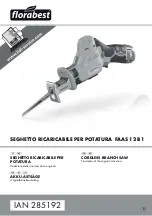
4
GB/IE/NI
4. Intended use
The sliding compound mitre saw is designed to crosscut wood
and plastic respective of the machine’s size. The sliding cross
cut mitre saw is not designed for cutting firewood.
Warning!
Do not use the sliding cross cut mitre saw to cut
materials other than those specified described in manual.
Warning!
The supplied saw blade is intended exclusively for
sawing the following materials:
wood, wood derived products (MDF, chipboard, plywood,
blockboard, hardboard, etc.), wood with nails and 3 mm mild
steel plates.
Note:
Wood containing non-galvanised nails or screws can
also be safely cut when carefully handled.
Note:
Do not use the saw blade to cut galvanised materi-
als or wood containing galvanised nails. Do not use the saw
blade to saw firewood!
The equipment is to be used only for its prescribed purpose.
Any other use is deemed to be a case of misuse. The user / op-
erator and not the manufacturer will be liable for any damage
or injuries of any kind caused as a result of this.
The equipment is to be operated only with suitable saw blades.
It is prohibited to use any type of cutting-off wheel.
To use the equipment properly you must also observe the safety
information, the assembly instructions and the operating instruc-
tions to be found in this manual.
All persons who use and service the equipment have to be
acquainted with this manual and must be informed about the
equipment’s potential hazards. It is also imperative to observe
the accident prevention regulations in force in your area. The
same applies for the general rules of health and safety at work.
The manufacturer will not be liable for any changes made to
the equipment nor for any damage resulting from such chang-
es. Even when the equipment is used as prescribed it is still im-
possible to eliminate certain residual risk factors. The following
hazards may arise in connection with the machine’s construc-
tion and design:
• Contact with the saw blade in the uncovered saw zone.
• Reaching into the running saw blade (cut injuries).
• Kick-back of workpieces and parts of workpieces.
• Saw blade fracturing.
• Catapulting of faulty carbide tips from the saw blade.
• Damage to hearing if ear-muffs are not used as necessary.
• Harmful emissions of wood dust when used in closed rooms.
Please note that our equipment has not been designed for use
in commercial, trade or industrial applications. Our warranty
will be voided if the equipment is used in commercial, trade or
industrial businesses or for equivalent purposes.
5. Safety information
General safety information for power tools
m
WARNING! Read all safety warnings, instruc-
tions, illustrations and technical data provided
with this power tool.
Failure to follow the warnings and in-
structions may result in electric shock, fire and/or serious injury.
Save all warnings and instructions for future refer-
ence.
The term “power tool” used in the safety instructions refers to
mains powered power tools (with power cord) and cordless
power tools (without power cord).
Workplace safety
a) Keep your workplace clean and well illumi-
nated.
Disorderliness and poorly illuminated workplaces may
Iead to accidents.
b) Do not operate the power tool in explosive
atmospheres with inflammable liquids, gases
or dust.
Power tools generate sparks which may ignite dust or va-
pours.
c) Keep children and other persons away from
the power tool during operation.
You may lose control of the tool if you are distracted.
Electric safety
a) The plug of the power tool must fit into the
socket.
Do not modify the plug in any way. Do not use adapter
plugs together with grounded power tools. Unmodified
plugs and matching sockets reduce the risk of electric shock.
b) Avoid body contact with grounded surfaces
such as pipes, radiators, ovens and refrigera-
tors. There is an increased risk of electric shock
if your body is grounded.
c) Keep power tools away from rain or humidity.
Water permeation into the power tool will increase the
risk of electric shock.
d) Use the cable solely for its intended purpose.
Do not use the cable to carry or hang up the
power tool or to pull out the plug from the
socket.
Keep the cable away from heat, oil, sharp edges or mov-
ing machine parts. Damaged or twisted cables increase
the risk of electric shock.
e) When working outdoors with power tools,
only use extension cords which are suited for
outdoor areas.
Using extension cords suited for outdoor applications re-
duces the risk of electric shock.
f) lf the operation of power tools in a humid en-
vironment cannot be avoided, you must use a
residual current circuit breaker.
The use of a residual current circuit breaker will reduce the
risk of electric shock.
Summary of Contents for 315340
Page 5: ...15 16 17 18 19 20 33 30 17 32 E 34 38 21 11 11 31 5 6 E E...
Page 20: ...15 GB IE NI...
Page 66: ......
Page 67: ......










































